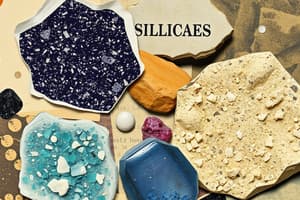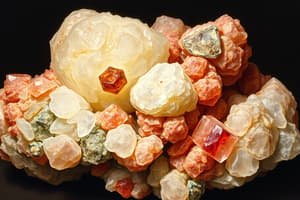Podcast
Questions and Answers
What is primarily formed when the silicate ion combines with various cations?
What is primarily formed when the silicate ion combines with various cations?
- Oxide minerals
- Luster minerals
- Silicate minerals (correct)
- Carbonate minerals
Which of the following best describes a method of mineral extraction?
Which of the following best describes a method of mineral extraction?
- Surface mining involves drilling deep shafts.
- Underground mining is used primarily for surface minerals.
- Underground mining is less efficient than surface mining.
- Surface mining extracts minerals from the earth's surface. (correct)
What characteristic is typical of silicate minerals?
What characteristic is typical of silicate minerals?
- They are exclusively found underground.
- They mainly contain metallic elements.
- They include silicate ions combined with + ions. (correct)
- They are primarily formed from carbon compounds.
Which of the following is NOT a mineral group?
Which of the following is NOT a mineral group?
How do silicates primarily differ from other mineral groups?
How do silicates primarily differ from other mineral groups?
Flashcards are hidden until you start studying
Study Notes
Minerals
- Essential natural compounds with a defined chemical composition and crystalline structure.
- Form the building blocks of rocks and can be classified into various groups based on their chemical composition.
Mineral Groups
- Minerals are categorized into distinct groups, primarily based on their anions or anionic complexes.
- Silicates, the most abundant mineral group, contain silicon and oxygen as the primary building blocks.
Silicate Minerals
- Silicate ion (SiO4) serves as a fundamental component, combining with various positive ions (cations) to create diverse silicate structures.
- Key silicate structures include chains (pyroxenes), sheets (micas), and three-dimensional frameworks (feldspars, quartz).
Mining Minerals
- Mining involves the extraction of valuable minerals from the earth, divided into methods based on the location of the ore.
Extracting Ores: Surface Mining
- Surface mining involves removing soil and rock above mineral deposits, allowing for easier access to minerals located near the earth's surface.
- Common techniques include open-pit mining and strip mining, suited for deposits that are horizontally expansive.
Extracting Ores: Underground Mining
- Underground mining is employed when minerals are located deep within the earth, necessitating advanced techniques and equipment.
- This method includes shaft mining and slope mining, focusing on minimizing surface disruption while accessing minerals more than a few hundred feet below ground.
Studying That Suits You
Use AI to generate personalized quizzes and flashcards to suit your learning preferences.




